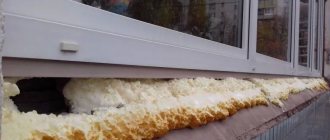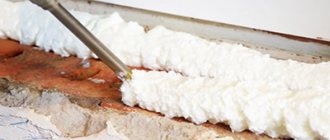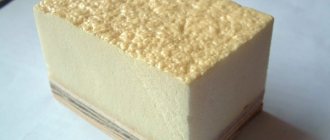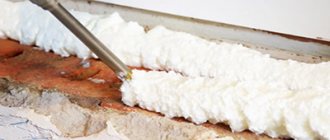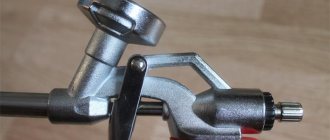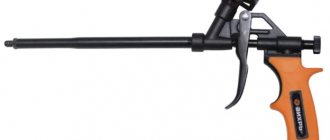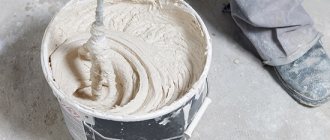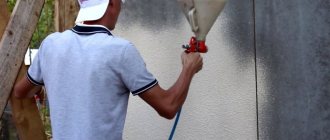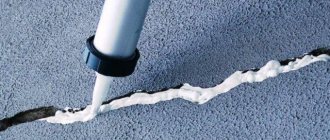How to use polyurethane foam correctly
Let's consider situations when it is advisable, and when it is not, to use polyurethane foam:
- You should not use foam to seal cracks less than 1 cm wide. Sealants or more plastic materials, such as putty, are better suited for these purposes. In addition, these materials do not have secondary expansion.
- If the width of the gap exceeds the 10 cm mark, before filling it with polyurethane foam, it is better to further reduce the space using wooden beams, bricks or any other sealant. This will significantly reduce foam consumption and increase its adhesion to the surface. Otherwise, under its own weight, it can simply slide along the walls of large cracks.
- The optimal size of gaps for filling with polyurethane foam is 2-8 cm.
- For faster polymerization and better adhesion of the foam to the adjacent surface, many recommend slightly moistening the walls before application. And then, spray the assembly seam with water from a spray bottle after initial hardening.
- It is not recommended to use foam on surfaces such as Teflon, silicone, polyethylene and other greasy or dusty walls. It simply will not stick to such materials.
- Be sure to consider the primary and secondary expansion ratios. This will help you understand how thick a seam needs to be placed in a gap of a certain width.
- Before using the can, be sure to clean the surface according to the instructions on the package.
- If the bottle is too cold or you brought it from the cold, keep it in warm water (no more than 20°C).
- To ensure better mixing of the components, turn the can upside down and shake for 1 minute.
- Wear protective gloves. Dried foam is very difficult to wash off.
- Do not touch freshly applied foam under any circumstances until it has hardened. You will not only get dirty, but also disrupt the structure of the material. This may result in poor cure or incomplete expansion.
- To ensure that the full volume of foam comes out of the container, be sure to hold it vertically and upside down until the job is completed.
- The polyurethane foam should have a pale yellow color throughout its entire service life. But you can notice that over time it may darken. This is caused by the harmful effects of ultraviolet rays, which destroy the structure. If possible, it is better to plaster or paint the seams, thereby protecting them from sunlight.
Using a can of household foam is very simple. Just screw on the tube and the working nozzle is ready. But if you still decide to purchase professional foam and a special gun, you need to be able to use it correctly. The principle of its operation is very simple - the gun is screwed onto the cylinder, after which the foam enters the barrel through the supply valve. It stays there until you pull the trigger. The material is then released at a predetermined volume.
basic moments:
- Choose guns that are made of solid metal only.
- To make cleaning and replacing parts easier, it is better to purchase collapsible rather than monolithic models.
- Immediately purchase a special cleaner.
- Before installing the gun on the cylinder, you need to unscrew the fastening screw, lubricate the socket with technical petroleum jelly and only then proceed to fasten it.
- You must first set the adjustment unit to the minimum foam consumption rate.
- Turn the can over and do a couple of test presses. This way you can visually assess the need to increase the flow and adjust the volume to suit your needs.
- Make sure that the cylinder is always in an upright position during operation.
- Upon completion of work or when replacing the cylinder, be sure to thoroughly clean the gun.
By following these key recommendations, you will easily cope with using any type of polyurethane foam.
How to cover foam on plastic windows from the street
To close the hardened protection from the street, it is recommended to use a waterproofing agent. A multifunctional sealant or waterproofing tape with a vapor permeability effect is suitable. Using this material will allow you to neatly close the seams on the front side without overlapping.
After installing the ebb, a vapor-permeable material is installed under it. It is important to measure correctly, then cut along the length of the window frame, taking into account the margin for installation under the external slope. If the existing width is not enough, then an additional piece of tape is cut off.
How to putty polyurethane foam - step-by-step diagram
Step 1: Level the foam
Foam traditionally has a wave-like structure and when it expands, its excess sticks out in the most unusual positions. Puttying or plastering on such a surface will not work, so first trim the dried material (at least 7-12 hours after application). If plaster is used to protect the foam, the seam must be further deepened by a few centimeters.
Step 2: Apply the tape
To protect a clean surface from stains, apply masking tape around the perimeter. The tape should be removed when the plaster has already been applied, smoothed and slightly dried.
Step 3: Working with the mixture
For work on polyurethane foam, almost any mixture will suit you, but the Rotband mixture has proven itself best. Following the instructions on the package, knead and carefully, working with a spatula, apply the mixture to the foam.
Step 4: Grout
When the material has dried, the unevenness is smoothed over with construction mesh or sandpaper. Good polyurethane foam can withstand pressure well, so you don’t have to be afraid to use force, as when grouting regular plaster.
How to choose?
The main parameters of the polyurethane foam are indicated on the label of the cylinder, and the operational features are indicated in the instructions
When choosing the right product, you should pay attention to the following factors:
- Cylinder volume. This indicator must be indicated on the packaging. Usually the volume of filling the container is indicated. It can range from 200 to 1000 ml. The most common option is 750 ml.
- Foam release after expansion. The product designation may contain a two-digit number after the brand (for example, 4 or 60). It indicates how much volume can be obtained after spraying in liters. For domestic conditions, this figure is selected within the range of 30-40 liters, and for professional use - 50-70 liters. This parameter is fixed at an average air temperature of 22-23 ºС and humidity of 50%. The foam yield is associated with such a characteristic as the coefficient of secondary expansion. For a quality product it is 1.2-1.4.
- Density. The strength properties of a material depend on its density. For household foam, the indicator is taken in the range of 26-34 kg/m³, and for professional foam – 18-26 kg/m³.
- Moisture resistance. It depends on the type of gas pores. Insulating properties are ensured when the content of closed pores is at least 87%.
- Adhesion. It must be provided to any surface in the room.
- Temperature at which the foam can be used. The temperature range is: for summer foam - 5-36 degrees, for winter foam - from minus 20 to plus 30 degrees, all-season foam - from minus 10 to plus 35 ºС. It is dangerous to heat the cylinder above 50 ºС. This heat can cause it to rupture.
- Viscosity. The consistency of the foam should allow it to remain stable in a vertical plane.
We recommend: Why are foam block sizes best suited for building a private home? Is it possible to make it yourself?
When choosing polyurethane foam, you need to check the quality of the product. The cylinder must not be damaged. With gentle shaking, you can determine the presence of liquid inside.
Variations
Selection of foam for installation
depends on the assigned tasks. For convenient application, saving money and your time, use a specialized design - a mounting gun. It allows you to manually adjust the required strip thickness and apply the volume of the cylinder to the end. If a large scope of work is expected, then it is better to purchase qualified foam for installation work. Its main difference is the non-standard mount for the pistol with which the cylinder is equipped.
Types of foam for installation
For small-scale work, homemade or semi-professional foam is suitable. The cylinders are equipped with a tube, thanks to which they fill hard-to-reach places.
There are these types:
- Multipurpose. Can be used at – 10 °C without warming up the container in advance. It has a fast polymerization process and a high yield of material;
- Winter. Apply to surfaces cooled to -18 °C;
- Summer. The characteristics of the material make it possible to apply it to heated surfaces, up to +35 °C.
Foam can reduce the level of vibration, noise, and rattling.
Application of polyurethane foam
Polyurethane foam has occupied that part of the market that, before its appearance, was dominated by traditional materials - cement, cork, bitumen, mineral wool tapes, plaster, etc. MP has established itself as a universal insulating material that fills cracks, glues surfaces, is moisture-proof, does not conductive of electricity, fireproof (this indicator depends on the flammability class of the MP). All this makes it possible to widely use polyurethane foam for sealing and sound insulation, and gluing materials. So, let's take a closer look.
Insulation (sealing)
Filling cracks in cold rooms (insulation);
Filling cracks and crevices in roofing materials;
Filling voids around window and door frames, as well as other structures;
Gluing
Fixing door and window blocks (and then there is no need to additionally screw or nail with screws or nails).
Fastening insulating and insulating materials to the walls (if it is necessary to insulate a room, for example, with foam boards, the question often arises: how to glue the boards to the wall? The simplest solution is polyurethane foam).
Soundproofing
MP allows you to reduce noise that occurs during the operation of pipelines, air conditioners or space heating systems. Foam is used to seal the junctions of hoods and air conditioners, and the gaps between pipes. And since there are no cracks, it means there will be no rattling or noise. Use of foam in everyday life
Installation of window and door blocks.
Filling cracks and voids during repairs and construction in country houses and city apartments.
Widely used during indoor renovations (for example, fastening wall panels, etc.).
Polyurethane foam can be used to seal cracks and holes on floating craft (boats, rafts, etc.)
As you can see, the possibilities of polyurethane foam are not limited. The only thing is that you need to know well how to use it correctly. To do this, we advise you to carefully read the instructions for use. The final result depends on how competent your actions are.
Measurement accuracy
A common mistake that nullifies further “scientific” calculations of raw material consumption is careless or “by eye” measurements of the object being sprayed with polyurethane foam. Firstly, you need to use special measuring instruments - laser rangefinders, tape measures, level gauges. The more accurate the measurements, the smaller the final error. Secondly, when taking measurements, simple geometric calculations of areas are not enough; it is necessary to examine the object for the presence of voids, cracks, beams and complex construction units that are subject to foaming.
Let me give you a simple example: a hangar needs to be insulated along its entire contour; under the ceiling there is a rectangular beam of 20x40 cm, 12 m long. It would seem an insignificant nuance. Now let’s calculate that we have a relatively flat ceiling with two additional edges of 40 cm each and a length of 12 m - this is 9.6 additional square meters or about 24 kg of raw materials with a layer of 5 cm. Not to mention the complication of the surface, which gives additional overspending. What if there are several of these beams? Or is it not a beam, but a channel with an even larger surface area? All this must be taken into account and strictly considered.
Stop water and other suitable options
Different suppliers offer their own range of waterproofing products. For example, Tytan Professional STD, Tytan Euro-line GUN, Hauser W&D, Tytan Professional Lexy 20, Tytan Professional GUN, Makroflex 65 Standart, Makroflex PRO. However, in practice, only the last option can be used for waterproofing
The manufacturer indicates that the foam has an optimal number of open and closed cells, which is important for waterproofing materials
In addition, special attention must be paid to compounds intended for sealing. Soudal offers a wide selection of these products
The household and professional lines contain compounds for sealing when installing door and window frames, window sills, blinds, thresholds, steps, etc.
Reference. Sealing is the process of making surfaces and joints impervious to gases and liquids using special materials.
It is also possible to find special mounting foams for waterproofing on sale. The most famous is the two-component moisture-resistant foam “Stop Water”, which can withstand gas and liquid pressure up to 1 bar and is chemically neutral. The foam is intended for installing windows and doors in flood-prone areas, for eliminating leaks, sealing cables, fixing pipes, gluing concrete rings, etc. Does not support combustion, class - B2.
Despite the availability of a significant number of options for polyurethane foam for waterproofing, this solution is not optimal. In theory, foam can be used quite successfully as a waterproofing material. But in practice it is necessary to use alternative options. And there is a large selection of them on the market.
We calculate the optimal amount of material
Correctly calculating the amount of building materials that you will need to perform one or another type of construction and repair work is not an easy task. We all know that wallpaper, tiles, glue, and everything else is usually purchased with a certain reserve. But what about sealants? It would seem that there is no point in calculating the exact consumption of the sealing compound, since you can always go to a hardware store and buy the missing material. But there are times when it is better to calculate at least the approximate amount of sealant in advance. For example, you order a material of a certain color, which will be made to order for you (the so-called tinting of the sealant in the mass). In order not to make a mistake and not to buy too much, you should use some calculations and formulas.
Manufacturers
Many manufacturers offer refractory compounds; large companies often have more than one option in their product range.
Soudal fire-resistant mounting foam 750 ml. Photo Petrovich
Here are some examples:
- Makroflex FR77 PRO with a fire resistance coefficient of 240 minutes and fire resistance class - B1;
- Tytan Professional B1, marking demonstrates the fire resistance class, one-component composition is intended for use at temperatures from -10 to +30 degrees;
- TECHNONICOL 240 PROFESSIONAL is a one-component foam characterized by an affordable price, which gives it an advantage over foreign analogues;
- Soudal offers three options at once: for domestic use, for professional needs and with the “Click & Fix” marking;
- OGNEZA EI240 is applied at temperatures from +5 to +35 degrees, operated - from -40 to +80;
- Penosil Premium Fire Rated Foam B1 - summer foam that can withstand fire for three hours;
- NULLifire FF197 is a one-component professional product from an American manufacturer;
- Remontix is a Russian-made foam with an optimal price-quality ratio.
These options for fire-fighting compounds are not a complete list of offers from manufacturers. Other businesses and firefighting equipment are presented separately.
How many kilograms are in a liter of polyurethane foam?
Theory:
Mass is a characteristic of a body, which is a measure of gravitational interaction with other bodies.
Volume is a quantitative characteristic of the space occupied by a body, structure or substance.
Density is a physical quantity defined as the ratio of body mass to body volume.
The relationship between liters and kilograms of polyurethane foam is determined by a simple mathematical formula:
V = m/p, where
V—volume; m—mass; p—density.
In the calculation, the density of the polyurethane foam was taken = 30 kg/m3.
The density of polyurethane foam can vary depending on temperature and pressure. You can find the exact density of polyurethane foam in reference books.
If you need to convert m3 to tons, then see the program for converting tons to m3.
If you need to convert kg to m3, then see the program for converting kg to m3.
Question answer:
Question: How many kg are in a liter of polyurethane foam?
Answer: 1 kg of polyurethane foam is equal to 33.3 liters.
Question: How many liters are in a kilogram of polyurethane foam?
Answer: 1 liter of polyurethane foam is equal to 0.03 kilograms (kg).
Solutions:
You can quickly solve this simple mathematical operation using our online program. To do this, enter the initial value in the appropriate field and click the button.
This page presents the simplest program for converting kilograms of polyurethane foam into liters. Using this online calculator, you can convert liters of polyurethane foam to kg and back in one click.
Polyurethane foam - composition
Polyurethane foam on the market is presented in one-component and two-component mixtures. Moreover, its overwhelming share belongs to one-component sealant.
The foam includes two main components - MDI and polyols. Mixed in a pressure cylinder, they turn into a one-component liquid prepolymer. When leaving the container under the action of the propellant gas (propellant), the substance enters into a polymerization reaction with water molecules present in naturally humid air.
Foaming occurs, the volume of the mass expands by 3 or more times, and the formation of a densely elastic durable substance with a porous structure - polyurethane foam. It will take approximately 24 hours for the reaction to complete and to cure completely.
In a two-component composition, an activator is added to the base (prepolymer). Being in the same cylinder, they are separated by a shutter and do not mix. When the lock is removed, activation and rapid polymerization occurs, independent of air humidity. The mass begins to harden immediately in the container.
The process lasts from three to ten minutes. In this short time you need to have time to use the entire composition. It takes 4 hours for the foam filler to completely harden. Considering the need for quick, skillful manipulations, it is advisable for specialists to work with this product.
In addition to the base and a mixture of liquefied gases (propane-butane), various additives are added to the foam composition to impart certain properties (fire resistance, increased adhesion): stabilizers, plasticizers, surfactants and others.
Volume of polyurethane foam in the bolt
Let's talk about brands
Among the manufacturers known on the market are Titan, Macroflex and Penosil. But this is not all...
Titan – the brand produces several types of MPs that differ in their specific focus and capabilities.
Along with conventional MPs, Titan's assortment includes foam with increased sound-proofing properties, with a fire-resistant filler (Titan Professional B1), as well as several types of multi-temperature MPs.
Macroflex. Russian manufacturer producing a full line of construction foam.
Household and professional MP, for different temperatures, with enhanced adhesive ability, with improved thermal insulation properties, etc.
Foamed. Wide range (about 20 types of MP). Personally, I have been using Penosil for several years. And I can only say good things about him. Excellent combination of price and quality…
Presented in two series: PENOSIL Gold, intended for professional builders, including fire-resistant and for different seasons, and a household series, PENOSIL Premium, whose element is used in major and local repairs.
Polyurethane foam consumption - main factors
Each type of material will have its own indicator. The consumption is written on the label (more precisely, its average value), but it is taken into account that these data are calculated for optimal conditions (temperature, humidity)
In this case, the degree of heating of the air and the directly treated surface is taken into account, so the practical volume diverges from the theoretical
No less important information on the topic: Polyurethane foam for penoplex
Each foam has an expansion option. This explains that the volume of some brands is enough for half the application area, while others are only enough for a third. There are three types of compositions:
- highly expanding;
- medium-expanding;
- weakly expanding.
You will understand the difference more clearly by watching the video:
Household mounting foam is of the highly expanding type. It can be used to seal fairly large cracks. At the same time, there is no need to fear for the integrity of the building structure. To preserve it, special spacers are installed prematurely.
Ambient temperature also affects foam consumption. The lower the temperature indicator (colder), the more material is consumed. A minus indicator also reduces the percentage of air humidity. And low humidity is reflected in an increase in foam volume, that is, the “stream” becomes thinner.
Window-how
Manufacturers of plastic windows are developing their own technological solutions designed to facilitate the installation process and guarantee long service life of windows. An interesting option is offered, for example, by the Group’s specialists - special panels 9 mm thick, trimmed on one side with a hard PVC sheet 1 mm wide, and on the other with rigid polystyrene. The design provides good vapor barrier and eliminates undesirable effects associated with freezing of the junction of the window and the opening. Finishing with PVC sheets provides a modern appearance, easy maintenance and no operating costs, and the film protects the slopes during installation and finishing work in the room. Among other things, such a panel makes it possible to deliver the window on a turnkey basis on the day of installation, which is not possible when using “wet processes”. In the latter case, the installation of the window lasts at least two days. For comprehensive finishing of a window opening, we also offer decorative corners made from solid PVC sheet by extrusion, covering the joint between the slope and the wall.
Subtleties of application
It should be understood that to seal small cracks it is more advisable to use sealants rather than polyurethane foam. This option is considered for seam depths up to 10 mm.
Features of using polyurethane foam with minimal expansion:
- For cracks up to 1 cm, you need to use more plastic materials, including sealants that do not have secondary expansion at all.
- A low expansion compound is better suited for 2-10cm gaps.
- For a gap of 10 cm or more, it is recommended to additionally use a sealant to reduce the space. This approach will reduce material consumption and reduce the likelihood of the composition slipping under its own weight.
- For improved adhesion, you can moisten the surface with water, and after initial drying, spray the seam with a spray bottle.
- While working, do not neglect personal protective equipment. Washing dried polyurethane foam is problematic; it may take several days for it to completely come off.
- Do not use foam when working with materials such as silicone, polyethylene, Teflon. Poor adhesion will also occur on dusty and greasy surfaces. The foam simply won’t stick to them, it will fall off.
- For better mixing of the composition, you need to hold the container upside down and shake well before applying.
- A cold cylinder must be preheated in water, but at a temperature not exceeding +20 degrees.
Before applying foam, you need to prepare the surface - clean, wipe off dust, degrease with an alcohol solution. For better adhesion, you should wet the seam, but this is not necessary. Under no circumstances should you touch foam that has not yet hardened. This may cause poor polymerization. The remains must be cut off after complete hardening.
To release the full volume of the composition, it should be held vertically until the work is completed. Throughout the entire period, the foam should have a pale tint. If the color has changed, it is not advisable to use the composition. The shade changes even after hardening under the influence of ultraviolet rays. To extend its service life, you can paint the dried mixture or plaster it. Then it will be less exposed to sunlight.
Using polyurethane foam is easy. To obtain the finished nozzle, you need to wind the tube. But you still need to learn how to work with a pistol correctly. The cylinder is screwed onto it, and the foam will be supplied through the tip after pressing the trigger.
Important points:
- Select only those cylinders that are made of solid material.
- Make a few test presses to adjust the feed level.
- First set the adjustment unit to minimum.
- Along with the foam, buy products to remove it.
- Make sure that the cylinder is in an upright position at all times.
- After each stage of work, clean the gun from particles of frozen mass.
Such recommendations are useful when working with each type of foam.
On video: Polyurethane foam with a low coefficient of expansion, rules of application.
Calculation formula
The calculation formula includes data on dimensions and seam configuration. If the seam is rectangular, then the formula is used for calculation: P = W * D, where P is the flow rate, ml/1m.p of the seam; W – its width, mm; G – its depth, mm.
For example, for a seam with the same depth and width of 10 mm, the consumption will be 100 ml per 1 m.p. seam
But there are triangular seams, so the formula changes: P = 0.5 * W * D
To apply this, you need to cut the tip at 45 degrees.
Types of fireproof foam, markings
Classification of fire-resistant compositions is carried out according to several criteria:
Scope of application. Household and professional. A significant part of the fireproof foam on the market is of the second type. Compositions for professional needs are produced in large-volume cylinders, the capacity of which exceeds 750 ml. They are designed to mount a pistol. Household formulations are equipped with a special plastic applicator tube. Professional foam has better resistance to open fire.
Professional fireproof mounting foam KRAFTOOL Kraftflex Premium B1 750 ml. Stroylandia Photos
Fire resistance class. The time during which the foam successfully resists the effects of an open flame depends on the fire resistance class, indicated by the marking on the cylinder:
- B1, highest fire resistance. Designed for insulation of buildings with increased fire safety requirements and with a maximum concentration of people. Used when installing stoves, fireplaces and other equipment that creates an increased danger. Retains properties during prolonged exposure to an open flame and does not support combustion.
- B2, middle class (level) fire resistance. Used for low-traffic structures. Cannot withstand open fire for a long time. When exposed to high temperatures, it melts and releases a small amount of toxins. Extinguishes on its own when the flame is removed. Suitable for sealing water supply, sewer and thermal communications.
- B3 - flammable foam, which is not popular in modern construction due to low efficiency, self-extinguishes when the flame stops.
Fire resistance coefficient is a parameter demonstrating the time of resistance to open fire at a temperature of 1000 degrees, measured in minutes, indicated in the marking, for example, EI 30. The foam does not catch fire and retains its own properties for 30 minutes. Compositions of this type are recommended for use in buildings with occupancy of no more than 300 people. EI 60 and EI 90 resist fire for 60 and 90 minutes, respectively, and are intended for use in educational and medical institutions, shopping centers. EI 120, EI 240 and EI 360 are compounds that provide the highest level of protection, resisting fire for up to 360 minutes. Suitable for buildings that have increased fire safety requirements.
Season of application, temperature conditions during application. There are summer, all-season and winter foam. Summer must be applied at temperatures from +5 to +30/35 degrees. All-season is recommended for use in summer or spring/autumn, so temperatures range from -5 to +30, in some cases - from -10 degrees. Winter foam is suitable for application at a temperature of at least -18; there are options that can withstand temperatures of -25 degrees, but they are not fire-resistant. In most cases, fire-retardant compounds are of the all-season type.
The expansion coefficient, which significantly affects material consumption, is measured as a percentage. Strongly expanding ones can increase in volume five times. Moderately expanding - three, weakly - two. Compositions with a low expansion coefficient are also common on the market; the minimum is 15%.
Reference. Using foam at sub-zero temperatures reduces the expansion coefficient. As a result, the volume of the mixture will be less than when used at higher temperatures.
Compound. One-component foam hardens at normal air humidity. Before application, it is recommended to moisten the surface to increase adhesive properties. To obtain the best result, the surface must be cleaned and primed. The two-component hardens during a chemical reaction.
Foam yield - the amount of composition obtained from one cylinder, measured in liters, often indicated in the labeling. The most popular options are those with a capacity of up to 65 liters.
How long does it take to dry? The time of film formation on the surface, processing and complete polymerization are shown on the cylinder.
Color. The main colors are red, pink, brown.
Regulatory requirements
The Internet has provided a real opportunity to perform calculations on the consumption of polyurethane foam online. Calculators can be found on various sites, but they are available only to confident users of the World Wide Web. Home craftsmen can also use the manufacturers' instructions indicated on the packaging, or regulated standards, if available. But in both cases, it is recommended to increase the obtained result in order to prevent the situation of emptying the cylinder at the most inopportune moment.
Please note that different polyurethane foams have different consumption per square or linear meter. Sealant consumption depends on a number of factors:
Sealant consumption depends on a number of factors:
- high-quality composition of polyurethane foam;
- the required depth of filled cracks, joints, junctions and other recesses;
- use a plastic tube or special gun when applying;
- presence of a dispenser;
- professionalism of the master;
- uniformity of mass distribution;
- percentage increase in volume;
- temperature and humidity conditions accompanying the working process.
The consumption of polyurethane foam in the standards used by estimators is calculated based on the performance of work in optimal conditions, using a professional mounting gun
At the same time, attention is paid to the mandatory moistening of surfaces before applying sealant, periodic shaking of the container, and uniform distribution of the mass in the bottom-to-top direction.
Calculation of the required amount of foam per square meter when installing window blocks is made taking into account the thickness of the seam of 35-40 mm and its location along the entire perimeter of the opening. For example, if the window has an area of up to 3 square meters, then the consumption of mounting sealant will be 1.24 cylinders with a capacity of 0.75 liters. If the opening is more than 3 square meters, then 0.7 of a cylinder of the same volume will be consumed per square meter.
In the case of laying thermally efficient blocks, about ten liters of foam will be needed per square meter. But this standard indicator is not final. Any construction company has the right to change the figure upward, justifying the amendment by the circumstances that have arisen. Individual standards are approved in accordance with the procedure established at the enterprise.
In the accepted state prices, there is another indicator of foam consumption - per 100 linear meters of seam. An example would be the renovation of balconies. In this case, four bottles of sealant with a capacity of 0.85 liters will be required. Many professionals proceed from a different, fairly simple formula. For four linear meters of a typical size gap, they “take” a liter of expanding volume of polyurethane foam. As a rule, this number is present on the cylinder. In other words, approximately the following correspondence is written on it - 900ml = 65l.
What happens if the installation of windows is not carried out in accordance with GOST
If all GOST standards are met when installing windows, the installation seams can provide a high level of protection from precipitation, sunlight and wind loads. In addition, they allow the opening to “breathe” - they release excess moisture out and prevent it from getting inside. In cases where the requirements are not met, window owners are faced with the following set of unpleasant consequences during the operation of their windows:
- blowing the structure around the perimeter of the frame;
- freezing of slopes and windows themselves;
- regular formation of condensation in the autumn-winter period;
- the appearance of mold and mildew;
- noticeable heat loss.
All of these problems are most often eliminated by reinstalling the window. That is, the structure is first dismantled, after which the product is reinstalled taking into account all standards. To avoid this, it is recommended to take a responsible approach to choosing a team of installers, and also do not hesitate to control the actions of workers. Read the special review on OknaTrade for what you need to pay attention to when installing windows.
The minimum service life of assembly joints must be at least 20 years. It is with these requirements in mind that building materials are selected. If attempts were made to save money when purchasing them, this will negatively affect the durability of the seam.
Technical properties of compression foam
There are several types of compression foam. Thus, wet foam has a water to air ratio of 1:5, dry foam – 1:20. A feature of compression foam is the high density of adhesion of bubbles to each other. Thanks to this, the foam coating is dense and stable, reliably enveloping the burning surface and preventing air from entering. This helps reduce the fire extinguishing time by 5–7 times.
A distinctive characteristic of NATISK technology is the transformation of 1 drop of water into 5 – 15 bubbles of compression foam. Due to the fact that the area of each bubble is significantly increased in size, the heat exchange between the foam and the burning surface increases. This helps to significantly accelerate the cooling of the burning area. The part of the foam that comes into contact with the fire turns into a vapor and then into a liquid state due to the wetting agents contained in the foam.
The low thermal conductivity of compression foam makes it possible to effectively protect interfloor partitions, which minimizes the risk of collapse or deformation of building floors as a result of intense burning. Therefore, this factor is very important when extinguishing in dense buildings, including in rural areas, as well as in forests.
